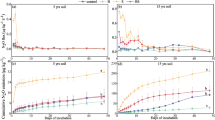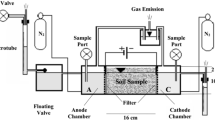Abstract
Purpose
A reclaimed tidal land along the shore has poor soil properties such as high exchangeable sodium percentage (ESP), and electrical conductivity (EC) due to excess sodium (Na) content. Therefore, Na content should be decreased to improve the land productivity, and for this, gypsum has been widely used. The objective of this study was to determine the changes in ESP and EC of the gypsum-treated reclaimed tidal soil in a field scale.
Materials and methods
For this, gypsum was applied to Daeho reclaimed tidal land (500 ha) in Korea for 5 years (2006 to 2010). The Daeho reclaimed tidal land has been used as reclaimed paddy fields since 1993. The application rate of gypsum was calculated based on exchangeable calcium (Ca) contents and soil cation exchange capacity (CEC) to maintain 60 % exchangeable calcium percentage (ECP) of CEC in soil and the average amount treated was 1570 kg ha−1 year−1. The changes in ESP and EC were monitored from 2006 to 2010, and 2013.
Results and discussion
The ESP dropped from 80 % in 2006 to 34 % in 2013. The EC of the soil was decreased by 73 %, from 11.5 dS m−1 in 2006 to 3.1 dS m−1 in 2013. Eventually, it was estimated that the ESP will be lowered below 15 % in 2023 with continuous treatment of gypsum according to ECP calculation, and EC will be declined to reach at 0.5 dS m−1 in 2035, the average EC level of Korean rice paddy.
Conclusions
This field scale study evidenced that gypsum application effectively improves the soil properties of reclaimed tidal soil by decreasing ESP and EC.



Similar content being viewed by others
References
Chen LM, Zhang GL, Effland WR (2011) Soil characteristic response times and pedogenic thresholds during the 1000-year evolution of a paddy soil chronosequence. Soil Sci Soc Am J 75:1807–1820
Chi CM, Zhao CW, Sun XJ, Wang ZC (2012) Reclamation of saline-sodic soil properties and improvement of rice (Oriza sativa L.) growth and yield using desulfurized gypsum in the west of Songnen Plain, northeast China. Geoderma 187–188:24–30
Cho JY, Son JG, Choi JK, Song CH, Chung BY (2008) Surface and subsurface losses of N and P from salt-affected rice paddy fields of Saemangeum reclaimed land in South Korea. Paddy Water Environ 6:211–219
Gharaibeh MA, Eltaif NI, Shra’ah SH (2010) Reclamation of a calcareous saline-sodic soil using phosphoric acid and by-product gypsum. Soil Use Manag 26:141–148
Güler M, Arslan H, Cemek B, Erşahin S (2014) Long-term changes in spatial variation of soil electrical conductivity and exchangeable sodium percentage in irrigated mesic ustifluvents. Agric Water Manage 135:1–8
Hanay A, Büyüksönmez F, Kiziloglu FM, Canbolat MY (2004) Reclamation of saline-sodic soils with gypsum and MSW compost. Compost Sci Util 12:175–179
Ilyas M, Qureshi RH, Qadir MA (1997) Chemical changes in a saline-sodic soil after gypsum application and cropping. Soil Technol 10:247–260
Jung YS, Yoo SH, An Y, Joo JH, Yu IH (2002) Changes in salinity, hydraulic conductivity and penetration resistance of a silt loam soil in a reclaimed tidal land. Korean J Soil Sci Fert 35:207–215
Jung YS, Lee WH, Joo JH, Yu IH, Shin WS, Ahn Y, Yoo SH (2003) Use of electromagnetic inductance for salinity measurement in reclaimed saline land. Korean J Soil Sci Fert 36:57–65 (in Korean)
Kim EK, Jung YS, Joo YK, Jung HG, Chun S, Lee SH (2009) Vegetation distribution and soil salinity on Daeho reclaimed tidal land of Kyonggi-Bay in the mid-west coast of Korea. Korean J Soil Sci Fert 42:447–453 (in Korean)
Kim HS, Kim KR, Yang JE, Ok YS, Owens G, Nehls T, Wessolek G, Kim KH (2016) Effect of biochar on reclaimed tidal land soil properties and maize (Zea mays L.) response. Chemosphere 142:153–159
Lee SH (2009) Soil characteristics and soil salinity changes in the reclaimed tideland of Korea. Korean J Soil Sci Fert 42:14–19
Lee SH, Hong BD, An Y, Ro HM (2003a) Estimation of conversion factors for electrical conductivities measured by saturation-paste and 1:5 water extraction. Korean J Soil Sci Fert 36:193–199
Lee SH, Hong BD, An Y, Ro HM (2003b) Relation between growth condition of six upland-crops and soil salinity in reclaimed land. Korean J Soil Sci Fert 36:66–71 (in Korean)
Lee YJ, Yun HB, Kim RY, Lee JS, Song YS, Sung J, Yang JE (2012) Determination of exchangeable cations in soils affected by different types of salt accumulation. Korean J Soil Sci Fert 45:135–142 (in Korean)
Lim CH, Kim SY, Kim PJ (2011) Effect of gypsum application on reducing methane (CH4) emission in a reclaimed coastal paddy soil. Korean J Environ Agric 30:243–251 (in Korean)
MAFRA (Ministry of Agriculture, Food and Rural Affairs) (2004) Studies on the changes of soil characteristics and utilization after tidal land reclamation. MAFRA, Gwacheon (in Korean)
NIAST (National Institute of Agricultural Science and Technology) (2006) Standard application of chemical fertilizer in the crops. RDA, Suwon (in Korean)
NIAST (National Institute of Agricultural Science and Technology) (2013) Monitoring project on agro-environmental quality. RDA, Suwon (in Korean)
Oster JD (1982) Gypsum usage in irrigated agriculture: a review. Fert Res 3:73–89
Qadir M, Qureshi RH, Ahmad N (1996) Reclamation of a saline-sodic soil by gypsum and Leptochloa fusca. Geoderma 74:207–217
Qadir M, Qureshi RH, Ahmad N (1998) Horizontal flushing: a promising ameliorative technology for hard saline-sodic and sodic soils. Soil Till Res 45:119–131
Qadir M, Schubert S, Ghafoor A, Murtaza G (2001) Amelioration strategies for sodic soils: a review. Land Degrad Dev 12:357–386
Qadir M, Qureshi RH, Ahmad N (2002) Amelioration of calcareous saline sodic soils through phytoremediation and chemical strategies. Soil Use and Manage 18:381–385
Qadir M, Steffens D, Yan F, Schubert S (2003) Sodium removal from a calcareous saline-sodic soil through leaching and plant uptake during phytoremediation. Land Degrad Dev 14:301–307
Rasouli F, Pouya AK, Karimian N (2013) Wheat yield and physico-chemical properties of a sodic soil from semi-arid area of Iran as affected by applied gypsum. Geoderma 193–194:246–255
Sohn YM, Kim HT, Jeon GY, Song JD, Lee JH, Park ME (2010) Effect of flooding treatment on the desalting efficiency and the growth of soiling and forage crops in a sandy soil of the Iweon reclaimed tidal land in Korea. Korean J Soil Sci Fert 43:16–24
Sumner ME, Miller WP (1996) Cation exchange capacity and exchange coefficients. In Sparks D.L. et al. (ed.). Methods of soil analysis. part 3. Chemical method. SSSA and ASA, Madison, WI. p. 1201–1230
Tejada M, Garcia C, Gozalez JL, Hernandez MT (2006) Use of organic amendment as a strategy for saline soil remediation: influence on the physical, chemical and biological properties of soil. Soil Biol Biochem 38:1413–1421
U.S. Salinity Laboratory Staff (1954) Diagnosis and improvement of saline and alkali soils. USDA Handbook 60, Washington, DC
Velmurugan A, Swarnam TP, Ambast SK, Kumar N (2016) Managing waterlogging and soil salinity with a permanent raised bed and furrow system in coastal lowlands of humid tropics. Agric Water Manag 168:56–67
Author information
Authors and Affiliations
Corresponding author
Additional information
Responsible editor: Maxine J. Levin
Rights and permissions
About this article
Cite this article
Kim, H.S., Kim, KR., Lee, SH. et al. Effect of gypsum on exchangeable sodium percentage and electrical conductivity in the Daeho reclaimed tidal land soil in Korea—a field scale study. J Soils Sediments 18, 336–341 (2018). https://doi.org/10.1007/s11368-016-1446-x
Received:
Accepted:
Published:
Issue Date:
DOI: https://doi.org/10.1007/s11368-016-1446-x




